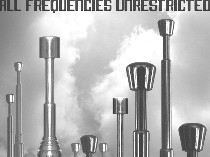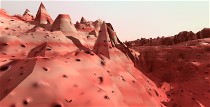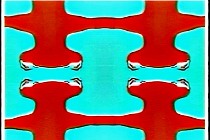Post by Colette Copeland
Images of mutant offspring come to mind with the name, Hyper-Runt. Curated by Emily Zimmerman and Ebon Fisher, Inliquid’s new media exhibit ended its brief run on Thursday evening.

My major complaint with new media exhibits has been that they are typically low on the visual aesthetic/high on concept. I for one would rather not sit at a computer terminal at a gallery, when I can comfortably access the sites from home.
Inliquid addressed this challenge, resulting in an exhibition, which is both experiential and conceptual.
Hyper-Runt refers to the offspring spawned from hybridization; the hybridization of artists collaborating with scientists and engineers as well as the hybridization of digital and organic processes, which produce unforeseen or new systems. The featured artists simultaneously embrace and question technology, science and information systems.
An installation by neuroTransmitter entitled, “All Frequencies” (2002/4) (top image), converts an image into sound waves, which are broadcast over radio airwaves. The installation consists of the source image (a poster created in 2003 during the FCC discussions around media de-regulation), an old TV displaying the sound waves, and two transistor radios playing the airwave frequencies. The resulting piece references the Cold War era, alluding to military surveillance and intelligence operations. A very timely reminder, given the impending election.
Ken Goldberg’s web project based on Fitt’s Law was disappointing. His talking head sculptures from the 2002 Whitney Biennial were brilliant in both concept and execution. This current project left me feeling very unsatisfied. I spent the time taking a test on-line, which included clicking back and forth on two lines as fast as I could. My result was 966 msec. The results did not give me a comparison to others or to the meaning of the numbers. I felt cheated—perhaps that was Goldberg’s intent.
Joseph Nechvatal and David Brody’s work addresses issues of transformation.

In Nechvatal’s “Black Attack” (2002) (left), a computer virus resembling small white bugs, slowly devours a densely layered, abstract color field. Installed in its own darkened room, the projected video has a beautiful tactile quality, which references both techno and biological viruses. Sounds of computer buzzing and insects crunching combine the synthetic with the natural.
Brody’s work entitled, “Proliferation” (2004), is an animated drawing of a Christian cross, which continuously transforms itself. Fortunately, the cross icon is not immediately apparent. The moving architectural structure resembles a microorganism or the child’s toy Kinex/ Legos, in which many pieces are constantly expanding and retracting. The absence of stasis suggests the perpetual shifting of ideology within power structures.
Other highlights included Natalie Jeremienko’s “Do Geese, See God,” (2003/4), Yael Kanarek’s “Hello” (2000), and klip//collective’s “Super Luminous” (2004).
Jeremienko collaborates with scientists, zoologists and Debra Solomon to create hybrid ecosystems, fostering unions between animals and humans. Solomon produces the food recipes, which are appealing to specific animal species and humans. I tried the geese/human food, which looked like black cubes covered with sesame seeds. It wasn’t bad. Apparently the geese in Germany liked it as well.

Kanarek’s computer piece (right, “Hello”) is an offspring of her larger work entitled, “World of Awe,” which I saw in the 2000 Whitney Biennial. The screen features an alien desert landscape, devoid of human presence. As the viewer moves the mouse across the computer monitor, a voice echoes, “helllooo”. This simple, yet poignant piece reinforces the notion of the human need to communicate face to face.

klip//collective’s video installation (left, “Super Luminous”) seduces the viewer with its eye candy appeal. The rear-projected video encompasses two doorways. The images result from feedback derived from source footage. The swirling kaleidoscope of colors produces a hallucinatory trance-like state.
Co-curator Ebon Fisher states that this is not the usual kind of art exhibit, with the multi-media blitzkrieg, leaving the viewers more dazed than moved. He suggests that culture is beyond the conscious production of artifacts. Hyper-Runt succeeds in taking viewers out of their ‘art’ comfort zone, yet also allows for the physical space with which to navigate the work.
Other artists in the show, which was up for only a week at the National Products Building, were Bigtwin, Shawn Brixey, Bradley Eros, Mark Napier, MTAA, and Caterina Verde.
–Regular artblog contributor Colette Copeland is a video-maker and installation artist.









